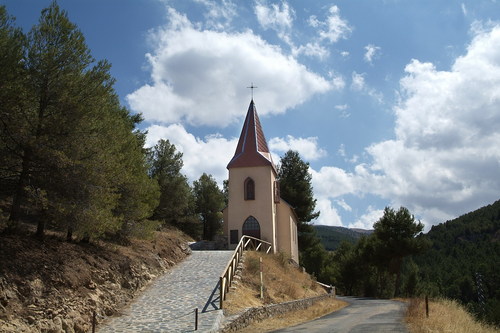The route proposal is an ascent from the same valley of the Almanzora River, starting from Tíjola until reaching the Calar Alto, through Serón, Las Menas and reaching the domes of the Calar Alto observatory. From there you descend to Bacares and from there back to Tíjola.
There is an optional route that can be made from Tíjola itself but in the direction of Bacares and from there take the Calar Alto route up the course of Bacares river.
Tíjola houses are the National Monument of the Parish Church of Santa María. Its altarpiece stands out in it. The quiet and beautiful square of Tíjola is a good place to take a rest and planning of the ascent to the Calar Alto. To do this you have to take the road to Serón, or the Tíjola exit where we will take the road that goes off to the left to ascend Bacares river up.
In Serón, we can visit the remains of the castle, famous for its resistance in the Moorish rebellion, and the clock tower. From there there are good views of the entire valley and village, organized around this defensive construction. You can walk through its streets and squares. Do not miss the opportunity to try the excellent ham made by the different factories and dryers of the town, which have led to an annual party in which ham and sausages are the protagonists. The parochial Church of Our Lady of the annunciation, of ends of century XVI, is an important sample of the Mudejar of the zone. In it you can see the shield of the Bishop of Portocarrero, promoter of this temple.
Leaving Serón towards Las Menas, take the road that leaves behind the hermitage of Nuestra Señora de los Remedios. The landscape leaves the valley in the background to get ahead by a winding road in the Sierra de los Filabres. To one side and another of the same the forest masses are growing as it ascends towards the mining town of Las Menas.
When you reach a fork, if you follow the road that goes up to Las Menas, on the left, a lane allows access to the recreational area of Las Jordanas.
As you climb you can see the cliffs and ancient remains of mining operations that were in a time of prosperity of the town. At an altitude of 1300 meters, conifers and holm oaks form the landscape. The first thing that is reached is the town of El Rascador and a small tower chapel with a pointed roof, similar to the constructions of alpine areas and that is now restored.
The mining town of Las Menas had more than 2000 inhabitants at its peak. The last workers, at the end of the 60s, abandoned the whole complex after the closure of the facilities. After many years of neglect the main facilities were converted into a hostel-restaurant that today offers travelers the possibility of enjoying a mountain setting with all comfort. For lovers of the mountain. Right next to the hotel is the campsite of Las Menas, ready to house the tents and information on walking routes throughout the area.
Following the road in an upward direction, the route enters a thick forest of conifers, fruit of the repopulation that the German Hispano Institute of Astronomy made when it located the Calar Alto Observatory of the Max-Plank Institute. (These facilities are located at an altitude of 2100 meters and their white domes are easily recognizable, there are visits arranged to see the facilities of this important astronomical observatory), Tel: 950 27 45 09 or 950 075 446.

